Walkabout: Readers' Favorites
Today’s favorite buildings are suggestions from readers, and all are among my favorite Brooklyn buildings, as well. They represent some of the most unusual and inventive architecture in Brooklyn, and are all worthy of separate, more informative posts at a later date. These are buildings built either for the civic good or as a gathering…


Today’s favorite buildings are suggestions from readers, and all are among my favorite Brooklyn buildings, as well. They represent some of the most unusual and inventive architecture in Brooklyn, and are all worthy of separate, more informative posts at a later date. These are buildings built either for the civic good or as a gathering place for the important men of the day.
To walk down New York Avenue, in Crown Heights North, and to suddenly come upon the old Methodist Home, is still a surprise and a delight – discovering a Dickensian institution transported into the middle of the city. Crown Heights North used to have several institutions designed to aid the poor, the orphaned and the elderly.
This is one of the few remaining, and is also the largest. This vast complex is a series of annexes, both old and newer, with the center building with the tower as its original building.

It was designed by Mercein Thomas, a successful Brooklyn architect who was very active in building in Clinton Hill. Thomas donated his architectural services, and the building was completed in 1889. At the time it was known as the Methodist Episcopal Home for the Aged.
It housed over 60 men, who were required to be over 65 years of age, and Methodists in good standing for at least ten years. The chapel was added in 1912, and is the jewel in the complex, with beautiful stained and painted glass windows. The buildings were abandoned in the 1970’s, and stood empty for years before being re-opened as the Hebron Seventh Day Adventist Elementary School.
A grant was recently obtained to redo the roof and do basic maintenance, and fortunately, this complex will soon be landmarked and protected in Phase II of Crown Heights North’s Historic District. This unique remnant of Victorian social reform is a favorite of Brenda from Flatbush and Bxgrl.
The Long Island Historical Society, now the Brooklyn Historical Society, was the last in a series of cultural buildings to be built in that part of the Heights.

It was once surrounded by the Brooklyn Academy of Music, the Brooklyn Art Association and the Mercantile Library, all around the corner on Montague St. Those buildings are now gone, and the BHS remains as one of the great Victorian buildings in NYC, not just Brooklyn.
A competition was held among Brooklyn’s finest to design the Society, and architect George B. Post, who had just recently designed the magnificent Williamsburgh Savings Bank in Williamsburgh, won out against some heavy hitters, including JC Cady, the Parfitt Brothers, George L. Morse, Hugh Lamb, and the venerable Alexander Jackson Davies.
His design, a massive cube with deep windows, is both a tribute to the Romanesque as well as Classical styles. What sets it apart from everything else is the profusion of ornamental terra cotta trim everywhere, as well as the masterpieces of sculpture that are the portrait heads on the front and side of the building.

The ornamental terra cotta was designed by Truman Hiram Bartlett, and the busts, counted among the Society’s greatest treasures, are by Olin Levi Warner, and include a Viking and a Native American on either side of the front entrance on Pierrepont, and portraits of Christopher Columbus, Benjamin Franklin, Shakespeare, Gutenberg, Beethoven, and Michelangelo.
The building was built between 1878 and 1881. The name was officially changed to the Brooklyn Historical Society in 1985, and it continues to be one of the most important repositories of Brooklyn history that we have. Our own Minard Lefever counts this as one of his favorites, and I heartily agree.
Lastly, we have the Montauk Club that absolutely delightful combination of Venetian Gothic architecture and Native American themes and portraiture, built in 1889-91. Where else can one enjoy the meeting of Venice’s Ca’d’Oro and Chief Wyandance of the Montaukett People, but on the façade of this building?

Brooklyn had many private social clubs by the turn of the century, and in 1889, a group of wealthy Brooklyn men, including Charles Pratt, Richard Schermerhorn and Edwin Litchfield, founded this club, and held a competition for an architect.
They chose the design of Francis H. Kimball, best known for his magnificent Emmanuel Baptist Church in Clinton Hill, as well as his monumental Rhinelander Mansion on Madison Ave and 72nd St, now famous as the Ralph Lauren flagship store. Kimball proposed a building with elements of Venice’s famous Ca’d’Oro, with its delicate quatrefoil Gothic tracery windows and balconies, now gaining popularity from the works of critic John Ruskin.
Through the generous use of terra-cotta and cast iron elements, Kimball introduced elaborate Native American themes into the building, with friezes depicting the sale of Long Island by the Montauk tribe, and the laying of the cornerstone of the building.
There are Indian faces on the columns, and incorporated into the cast iron fencing surrounding the property. Stained glass set into Gothic windows aid in casting an exotic and appealing atmosphere at the rare three sided exposure, and the building is one of the most popular and most photographed buildings in Brooklyn.
The Club was one of the first to allow the members’ wives to gather, building them a separate entrance to the rooms upstairs. By the end of the 20th century, however, the Montauk Club was almost bankrupt, and sold the top three floors to be developed as private apartments in order to remain solvent, and make necessary repairs.
A resurgence in club membership occurred in the last few years, and the club is successful once again, this time among upwardly mobile young professionals, and of course, is now open to both men and women members. Thanks, BrooklynSoFar, for your suggestion of this landmarked masterpiece. Please check my Flickr page for photographs of all three buildings.





No pigeon- you’re suffering from excellent taste (Who would have thought someone who pecks crumbs on the sidewalk could be so artistically refined ? 😉
It hurts to think of the “heart-achingly beautiful” building torn down and replaced with “run-of-the-mill edifices.”
I must be getting old.
NOP- the horrible hulking old wreck of a building that was the Bronx nursing home my grandmother went into made the Hebron School look like Disneyland. It looks so forbidding, but when I look at the Hebron School it’s like looking into another world. I would love love love to get a tour.
The Mercantile Library on Montague Street was designed in a Venetian Gothic style to harmonize -no pun intended- with the original BAM across the street. Both were heart-achingly beautiful buildings. Both lost and replaced with run-of-the-mill edifices. There are many old photos of these buildings.
Montrose:
Great post about three buildings that I know.
Sister Woman married at the Montauk Club, as a good Brooklyn girl should.
And I did research at the Historical Society while at Columbia.
But it’s the old Methodist Home that looms largest for me, perhaps because I found it so compelling as a boy living in Crown Heights during the 1950s.
The photographs make it look pretty grim — Dickensian, to paraphrase BxGrl. But back then it seemed more like a great castle, half hidden by trees. There weren’t the chain link fences there are now, but wrought iron ones that gave the grounds the impression of a private park. There were also some very good apartment houses at the intersections of New York Avenue and Park and Sterling Places, where friends enjoyed views of both the building and landscape.
The Home was so big it could only be perceived in pieces, at least in my small brain. The gables, the porches, the chapel. And on the porches sat little old people in rows. (And I remember women among them. Perhaps by the 1950s residence rules had changed? Or perhaps I’m confusing staff with residents?)
But what left the biggest impression was that this — the largest and most dramatic building in Crown Heights — was never discussed. No parent pointed at it and said “that’s where old people go”; no kid lingered to make comment. As if people didn’t want to think about death and dying or that to speak about old people would be in bad taste. (As an adult now, I can see self-consciousness, even shame, taking a role. How many parents saw the possibility of being shunted into such a place? How many had actually sent their own parents to such a place?)
New York Avenue had a bus at the time. During Christmas, a large wreath was hung over the Home’s entrance. If it were snowing and I took the bus from my orthodontist on Eastern Parkway, the wreath and yellowish light from the building’s many windows made the place magical in the twilight.
Still, I never saw anyone enter or leave the gate.
Nostalgic on Park Avenue
Pigeon, I hope to do some digging around at the BHS, and find photos of all three buildings. I have seen pictures of the old Academy of Music. More fodder for upcoming posts in 2010.
Thanks, Minard. Ya never know.
A good day on Brownstoner. Both Montrosse’s lucid and intelligent narrative as well as Junkerfeld’s fascinating collection of images from the Civic Center make today’s blog a real treat.
Montrosse should contact the BHS and set up lectures. I’m sure she would draw a good audience. She already has a large following of fans from this blog.
20 years ago, shortly after I first moved to NYC, I was invited to a social function at the Brooklyn Historical Society. I’ll never forget my awe at the regal and magestic feeling of the building.
MM says the BHS was “the last in a series of cultural buildings to be built in that part of the Heights. It was once surrounded by the Brooklyn Academy of Music, the Brooklyn Art Association and the Mercantile Library…” Very interesting.
Does anyone know if those buildings were as beautiful as the BHS?
Very glad to hear it’s going to be preserved/repaired. Beautiful building. I looked at a house across the street from it on the Sterling side, but remember feeling distinctly nervous that this building with its enormous lot (it takes up almost half a block) would be razed by developers.